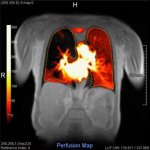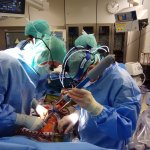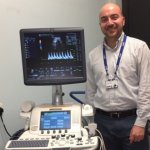
News • Adaptation to hypertension
"Cell chatter" critical for arterial thickening
New research shows that cell-cell signaling could play a key role in the thickening of arteries due to high blood pressure.

New research shows that cell-cell signaling could play a key role in the thickening of arteries due to high blood pressure.

Similar to the way exercise helps muscles adapt to workouts, short, repeated bouts of reduced circulation with a blood pressure cuff may help prevent the worst outcomes of heart attacks and strokes.

Networks adapt over time and in this way form a kind of memory. German researchers show that the structure of blood vascular network is dynamic and can adapt to external factors.

When every minute counts: A Swiss team is currently developing a diagnostic procedure that can be used to start a tailored therapy for acute stroke in a timely manner.

Advances in image post-processing and contrast-enhanced techniques have widened the scope of possibilities for MRI and ultrasound vascular imaging, experts showed in a dedicated course at the ECR Overture.

Two successive studies highlight advances in non-invasive 3D ultrasound imaging, making it possible to observe blood flow in real time in the heart and the brain.

Recently, a Korean research team has developed a 3D foot imaging technique that vividly captures peripheral blood vessels, even thinner than 1 mm. It combines photoacoustic and ultrasound images.

A team of researchers are developing the use of an artificial intelligence (AI) algorithm with the aim of diagnosing deep vein thrombosis (DVT) more quickly and as effectively as traditional radiologist-interpreted diagnostic scans, potentially cutting down long patient waiting lists and avoiding patients unnecessarily receiving drugs to treat DVT when they don’t have it.

Researchers have found a way to reduce organ rejection following a transplant by using a special polymer to coat blood vessels on the organ to be transplanted. The polymer, developed by Prof. Dr. Jayachandran Kizhakkedathu and his team at the Centre for Blood Research and Life Sciences Institute at the University of British Columbia, substantially diminished rejection of transplants in mice when…

Royal Philips announced that it has signed an agreement to acquire Intact Vascular, Inc., a U.S.-based developer of medical devices for minimally-invasive peripheral vascular procedures. Intact Vascular will enhance Philips’ image-guided therapy portfolio, combining Philips’ interventional imaging platform and diagnostic and therapeutic devices with Intact Vascular’s unique, specialized…

In the world of laboratory diagnostics, ‘Abbott’ is a household name. Few people however are aware of the fact that the company, headquartered in Illinois, USA, is also leading in other fields. A number of innovations in cardiac and vascular diagnostics and therapy might soon put Abbott in the limelight. Dr Angela Germer, Regional Director DACH, and Volker Keller, Head of Marketing DACH,…

A new technique could enable vascular surgeons to reach even the more difficult body regions. Instead of pushing catheters into minute veins, the system, devised in Canada by Professor Sylvain Martel and team at the Polytechnique Montréal Nanorobotics Laboratory, uses magnetic forces to pull a guidewire, or catheter, into remote physical locations, guiding medical instruments into narrow and…

Interventional radiotherapy for tibial arteries has increased in recent years. Why? People are getting older and better techniques and materials now permit treatment even of very thin vessels. Professor Dierk Vorwerk, Director of the Institute for Radiology at Ingolstadt Hospital, where almost a third of all interventions in his department are performed on the lower leg, described the most…

Patients with the rare Loeys-Dietz syndrome suffer from aortic enlargement which may result in sudden over-expansion and a fatal aortic tear. In order to prevent this from happening, an aortic prosthesis must be implanted. A team of vascular surgeons at the University Hospital of Zurich was one of the first in the world to risk undertaking this life-saving operation on a child as an emergency…

A new survey will give patients, carers and members of the public the opportunity to have their say in what they think is important for future research for vascular conditions. The Vascular Priority Setting Partnership (PSP) survey, developed in partnership with the James Lind Alliance aims to identify unanswered questions about the prevention, diagnosis and treatment of vascular conditions from…

A discovery by researchers at Queen’s University Belfast and King’s College London (KCL) could revolutionise treatment for vascular and diabetes related cardiovascular diseases.

Fabrizio d’Abate, St. George’s University Hospitals NHS Foundation Trust, in London, UK describes new aspects of learning and training in ultrasound operation: "A textbook represents the most traditional tool of a teaching arsenal. However, the IT boom and internet have transformed the way people approach different tasks in their lives, from solving a problem to acquiring knowledge. This…

Horiba Medical announces the availability of a D-Dimer reagent for their semi-automated Hemostasis instruments. The D-Dimer is a key measurement and the reference exclusion test for the diagnosis of deep vein thrombosis or pulmonary embolism and may also be used for monitoring Disseminated Intravascular Coagulation. The new Yumizen D-Dimer reagent kit is available for Yumizen G hemostasis…

Space missions are famous for driving innovation, from Mylar blankets to microchips. So when French scientists learned one of their compatriots would be aboard the Soyuz MS-03 spacecraft to reach the International Space Station (ISS), they gathered cutting edge technologies for him to carry into orbit.

It is a collaboration that could push vascular imaging to a new level.

FUJIFILM VisualSonics Inc. announced a significant milestone in its history with the installation of the first Vevo® MD Ultra High Frequency (UHF) clinical ultrasound system at the Second University of Naples in Italy. With multiple successes in preclinical research over the last decade, the Vevo® MD is FUJIFILM VisualSonics’ first foray into the clinical market.

Pentax Medical launches a world first for endoscopy, the OPTIVISTA EPK-i7010 Video Processor, featuring both digital and optical enhancements, in the European, Middle Eastern & African (EMEA) markets. This unique enhancement combination provides detailed information for more accurate endoscopic in vivo diagnosis through improved vessel and mucosal pattern characterization.

Impacting on clinical decisions. Accelerating clinical routine. Following the release of its new Version 6 software upgrade for the Aplio Platinum Series ultrasound system, Toshiba has received high marks for the enhanced functions and performance from practitioners, each offering specific insights into how they are applying the technology.

Across the country, many employees are seated at desks for the majority of an eight-hour workday. As technology creates an increase in sedentary lifestyles, the impact of sitting on vascular health is a rising concern. Now, researchers from the University of Missouri School of Medicine have found that when a person sits for six straight hours, vascular function is impaired — but by walking for…

Blocked blood vessels can quickly become dangerous. It is often necessary to replace a blood vessel – either by another vessel taken from the body or even by artificial vascular prostheses. Together, Vienna University of Technology and Vienna Medical University have developed artificial blood vessels made from a special elastomer material, which has excellent mechanical properties. Over time,…